
Best of Times, Worst of Times for Unions
- Breaking News
BLS Report Shows Increasing Organizing Success But Continued Overall Union Membership Decline
On January 19, the Bureau of Labor Statistics released its annual report regarding union membership. First, the good news for unions: membership increased by 273,000, one of the highest increases in several years. Of that total, 80,000 were in the public sector. Now the bad news for unions: union membership as a percentage of the workforce declined from 10.3% in 2021 to 10.1% in 2022, as the overall workforce grew by 3.9%. Private sector union membership declined to 6% (7.2 million), while public sector membership declined to 33.1% (7.1 million). The proportion of the private sector workforce that is unionized and the proportion of the overall workforce that is unionized are the lowest since BLS began compiling this data in 1983.
Let’s focus on the 273,000 gains: 193,000 in the private sector. Unions filed more election petitions last year than any year since 2015 and won approximately 70% of those elections. Millennials, who are the single largest workforce age demographic, support unionization at a rate of 74%, which is the highest rate of support for unionization of any demographic. The notoriety of Starbucks, Amazon, and Apple unionization efforts have led some employees in other industries to think “if they can do it, why not us?” Unions also offer this social-media-driven generation an opportunity to be real life influencers. This opportunity to lead and engage can contrast sharply with top-down workplaces that emphasize uniformity and eschew deviation.
Employers should expect to see unionization drives and elections increase in 2023 based on pro-union sentiment, savvy media exploitation by unions to keep otherwise numerically-insignificant campaigns in the public eye, and a raft of NLRB gifts by the Labor Board and its General Counsel, as we discussed here.
Employers should assess their workplace culture and policies for unionization vulnerability. With a 6% private sector membership level, most supervisors and employees have no personal or family experience with unions (real life union experience often being at best a mixed bag and certainly less rewarding than what unions promise during a campaign). Consider a vulnerability audit and interactive training to be sure your organization sustains its union-free status.
If you have any
questions regarding union organization and membership, please contact Richard
Lehr at 205-323-9260 or rlehr@lehrmiddlebrooks.com.





